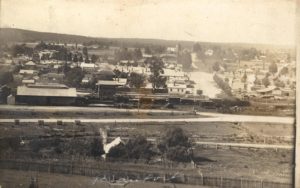Katharine Kirkland according to her writings in ‘Life in the Bush’ arrived ‘over the straits’ from Tasmania about February 1839 to settle in the (then) Port Phillip District of New South Wales. The Kirkland’s party, consisting of extended family members, including Agnes, the Kirkland’s young daughter, moved with their dray, bullocks, horse, provisions, and sheep to take up a run at Trawalla. Their neighbours were the Learmonth brothers who had moved from Buninyong to Ercildoune. Katharine was one of the few women in early Victoria, and she resided at Trawalla near Beaufort.
The lives of pastoralists (like the Kirklands) around Beaufort changed forever when gold was discovered at Yam Holes Hill in 1852 and at Waterloo in 1853. By 1854 Yam Holes Diggings was known as “Beaufort Poor House” because in times of unemployment prospectors would fossick for a little ‘colour’. On 14 March 1855 the Gold Escort took 7374 oz. of gold with a value of ₤30,000. Late in 1855 the rush to Fiery Creek Diggings began at Golden Point near Mr. Watkin’s gardens and extended for two kilometres from Musical Gully towards Beaufort. By 1856 the goldfield extended to included Wingfield’s Gully, Waterloo Flat and Sailor’s Gully and over 300,000 oz. of gold had been extracted.
Beaufort’s population reached around 50,000 in 1857 only to fall to 3,800 in 1858. Accompanying this boom in population were stores, shanties, a billiard saloon, a dancing booth and on either side of the narrow street were tents of all sizes and descriptions. People from Britain, America, Germany, Sweden, Italy, China, Wales, and including those from all walks of life, parsons, lawyers, doctors, accountants, tradesman, and labourers had converged on Beaufort in 1857.
During the early 1860s deep lead mining commenced at Southern Cross and Garribaldi (Jocks) Leads, puddling machines and sluices began working over the old alluvial ground, with horse power being the main source of power, although some mines like Allen and Co. began to use steam power. According to the Mining Registrar the only unoccupied mining ground was the police paddock!
Some sluicing companies and mines of the time had descriptive names. Among these were the Dancing Feather, Phoenix (Main Lead), Red Hill (Nuggetty Gully), Wimmera, Watkins, Bill’s Hill (Waterloo), West of England, and Yam Holes Hill Sluicing Company, and the Southern Cross Lead, Garribaldi Lead, Shamrock and Thistle, Cockatoo Co., Champion of the Seas (after the vessel that brought the immigrants to Victoria), Olive Branch, and the Flying Bird Company. In the mid 1860s Charlton, Crinoline, and Prince of Wales were operating on the Sulky Gully Lead at Charlton (later renamed Chute 1881). During the late 1860’s and early 1870’s there were four quartz reefs where work began but only one, the Richmond Quartz Reef, reached the mining stage. There were many Chinese puddling in the 1870s. The Chinese camp and later market garden being situated on the western side of the Main Lead Road.
Mining ceased at Beaufort around 1918 when the dredge on Yam Holes Hill closed. The water level in the mines was a problem, so that as each of the mines closed it became more difficult and costly for the remaining mines to pump out the water. Today, the mullock heaps of the Sons of Freedom group of mines, on the Raglan/Chute Road are well worth a visit, as is the mullock marking the site of the Victoria at Waterloo. Still visible in a few spots are the remains of the tramway built to take ballast for the railways from the Victoria site to the station at Trawalla.
Photograph (right) Beaufort, State Library of Victoria
